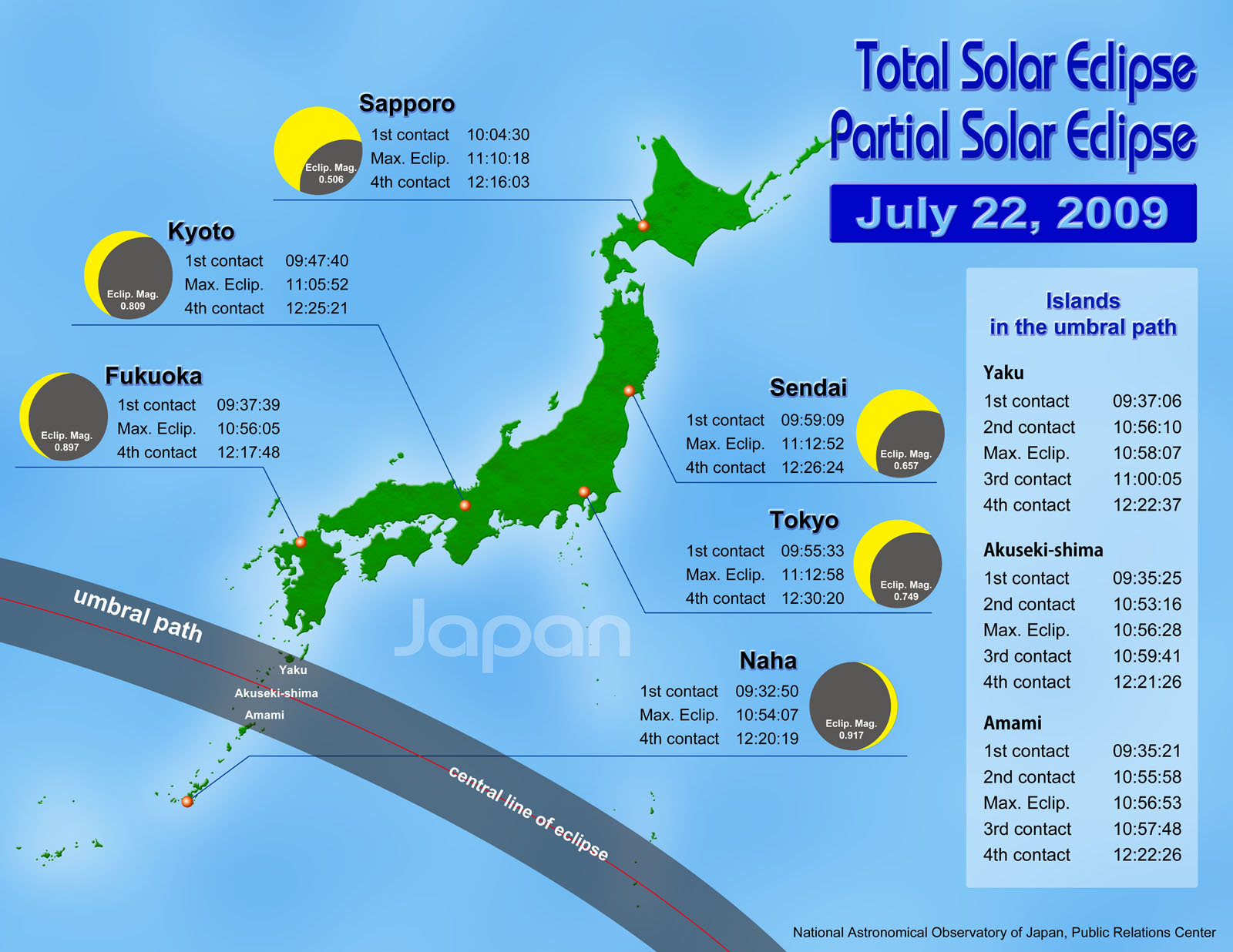Total Solar Eclipse 2009
| Topics
Introduction
On Wednesday, July 22, 2009, a total solar eclipse is visible within a narrow corridor that travels Japan's Ryukyu Islands. A partial eclipse is seen within the much broader area, which includes most of Japan. For example, Tokyo, Japan's capital city witnesses a partial eclipse of magnitude 0.747. Although conditions of this total eclipse, i.e., the length of totality, the altitude of the Sun, and so on, are very good, weather prospects are a major concern.
The Shadow's Path

The umbra path encounters Japan's Ryukyu Island (also known as Nansei Islands) at around 10:55 (JST, Japan Standard Time which is 9 hours ahead of UT.). Yakushima, the largest island in the path is near the northern limit and experiences 3min 57s of totality. Akuseki-shima is the closest to the central line; it gets a 6min 20s total eclipse. The path also encounters the remote Japanese islands of Iwo Jima and Kitaiwo Jima. The durations of totality from the two islands are 5min 13s and 6min 34s, respectively. A partial eclipse is seen within most of Japan.
A table below summarizes Japan's local times of first, second, third and forth contact. The 6th and 7th columns show the maximum eclipse magnitude and the epoch of maximum eclipse, respectively. Note that the JST listed below corresponds to the UT+9hours. The data were calculated by Ephemeris Computation Office, NAOJ.
| City | 1st contact | 2nd contact | 3rd contact | 4th contact | Mag | Max. Epoch |
|---|---|---|---|---|---|---|
| Sapporo | 10:04:30 | --- | --- | 12:16:03 | 0.506 | 11:10:18 |
| Sendai | 09:59:09 | --- | --- | 12:26:24 | 0.657 | 11:12:52 |
| Tokyo | 09:55:33 | --- | --- | 12:30:20 | 0.749 | 11:12:58 |
| Yokohama | 09:55:17 | --- | --- | 12:30:37 | 0.756 | 11:12:58 |
| Nagoya | 09:49:51 | --- | --- | 12:26:53 | 0.793 | 11:07:55 |
| Osaka | 09:46:58 | --- | --- | 12:25:22 | 0.822 | 11:05:28 |
| Kyoto | 09:47:40 | --- | --- | 12:25:21 | 0.809 | 11:05:52 |
| Kobe | 09:46:24 | --- | --- | 12:24:51 | 0.824 | 11:04:53 |
| Hiroshima | 09:41:24 | --- | --- | 12:20:29 | 0.857 | 10:59:41 |
| Tokushima | 09:45:00 | --- | --- | 12:24:48 | 0.850 | 11:04:02 |
| Fukuoka | 09:37:39 | --- | --- | 12:17:48 | 0.897 | 10:56:05 |
| Island | 1st contact | 2nd contact | 3rd contact | 4th contact | Mag | Max. Epoch |
|---|---|---|---|---|---|---|
| Akuseki-shima | 09:35:25 | 10:53:16 | 10:59:41 | 12:21:26 | 1.039 | 10:56:28 |
| Iwo jima | 10:01:04 | 11:25:26 | 11:30:45 | 12:52:49 | 1.016 | 11:28:06 |
| Kikai shima | 09:36:08 | 10:56:50 | 10:59:01 | 12:23:32 | 1.002 | 10:57:55 |
| Kitaiwo Jima | 10:00:25 | 11:23:47 | 11:30:26 | 12:51:40 | 1.034 | 11:27:07 |
| Kuchino shima | 09:35:59 | 10:54:03 | 10:59:45 | 12:21:34 | 1.022 | 10:56:54 |
| Nakano shima | 09:35:56 | 10:53:53 | 10:59:54 | 12:21:38 | 1.026 | 10:56:53 |
| Suwanose shima | 09:35:38 | 10:53:29 | 10:59:49 | 12:21:30 | 1.034 | 10:56:38 |
| Takera jima | 09:34:46 | 10:52:48 | 10:58:47 | 12:20:00 | 1.025 | 10:55:47 |
| Yaku shima | 09:37:06 | 10:56:10 | 11:00:05 | 12:22:37 | 1.009 | 10:58:07 |
NASA's Solar Eclipse Bulletin
For more about the 2009 total eclipse, see the NASA bulletin. The 86-page publication contains detailed local predictions, tables, maps, and weather prospects. The bulletins are also available online in PDF format. Additional information, updates, maps, and diagrams are available at NASA's official eclipse website.
Getting Weather Information
Japan Meteorological Agency. Japan Meteorological Agency provides forecasting services which encompass a wide range of meteorological information such as warnings and advisories further to forecasts. Daily, one-week, and seasonal weather forecasts are available via internet. See weather forecasts of Kyushu (South), Kagoshima, and Amami areas for the total eclipse. Be careful of typhoons which are the western Pacific's equivalent of hurricanes. In Japan, July is the midst of the typhoon season.